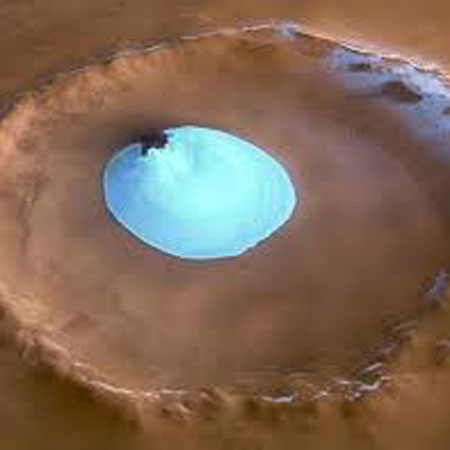Detecting ice holes on Mars
NASA scientists have discovered a dry underground ice pit containing lots of carbon dioxide. These carbon dioxide traps are thought to have originated from Mars's atmosphere for a long time, when it was the constituent element of life on this planet.
'This is a' buried treasure ', said Jeffrey Plaut, a scientist at the NASA Jet Propulsion Laboratory Center , in a report published in the journal Science. 'We found something underground that no one knew that it was there. '

The discovery was made possible by a cross-ground radar system of the Mars Reconnaissance Satellite, which is responsible for tracking the clues of life on the planet, wrote Empowered News .
The latest recorded volume of ice is about 3,000 cubic miles , capable of containing enough carbon dioxide nearly twice the entire volume of Mars atmosphere. The Martian atmosphere has 1% lower surface pressure than the Earth's surface pressure at the lowest elevations. The atmosphere on this planet also contains up to 95% carbon dioxide, while on Earth, carbon dioxide accounts for only 0.04%.
' We know there is a small permanent ice cap containing carbon dioxide on it, but this buried strip has 30 times the amount of ice expected, ' said Roger Phillips, a researcher at Southwest Research in Boulder City. , state of Colombia confirmed. Phillips is the deputy head of the research team at the Mars Reconnaissance Satellite Radar and author of the study.
- 'The black hole in the sky' drains the Earth's neighbor's ocean?
- Video: Detecting the sign of Mars around the equator
- Detecting aliens home on Mars?
- Detecting snow on Mars
- Detecting stone bridge on Mars
- Detecting 'ghost dust' on red planet
- Humans can live in pits on Mars
- Detecting new gravitational waves from two colliding black holes
- Detecting a 20km lake under the surface of Mars
- Detecting water in the Martian equator
- The risk of spreading bacteria from Earth to Mars
- Detecting black holes
 Van Allen's belt and evidence that the Apollo 11 mission to the Moon was myth
Van Allen's belt and evidence that the Apollo 11 mission to the Moon was myth The levels of civilization in the universe (Kardashev scale)
The levels of civilization in the universe (Kardashev scale) Today Mars, the sun and the Earth are aligned
Today Mars, the sun and the Earth are aligned The Amazon owner announced a secret plan to build a space base for thousands of people
The Amazon owner announced a secret plan to build a space base for thousands of people